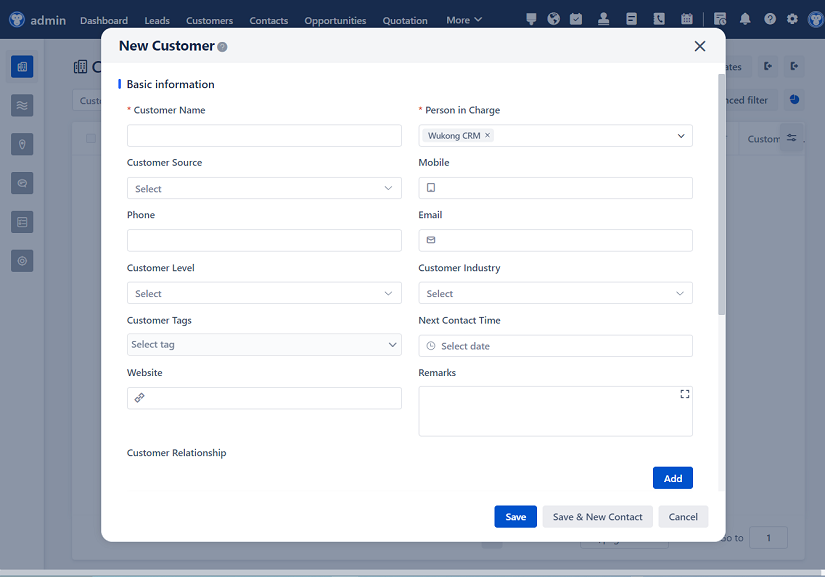
△Click on the top right corner to try Wukong CRM for free
Alright, so let me walk you through this whole idea of how a CRM department should be structured—because honestly, I’ve seen too many companies mess this up. You know what I mean? They throw a few people into a room, call it “CRM,” and expect magic to happen. But it doesn’t work like that. CRM—Customer Relationship Management—isn’t just software. It’s a strategy, a mindset, and most importantly, it needs the right team structure to actually deliver results.
So, picture this: you’ve got a growing company, customers are coming in faster than you can keep up, and suddenly everyone’s complaining—sales says marketing isn’t giving them good leads, marketing blames sales for not following up, and customer support feels like they’re cleaning up everyone else’s mess. Sound familiar? Yeah, that’s usually when someone says, “We need a CRM department.” But here’s the thing—just naming it doesn’t fix anything. You need a clear design diagram, a real organizational structure that makes sense.
Free use of CRM system: Free CRM
Let me break it down. First, who’s in charge? You need a CRM Director or maybe a Head of CRM. This person isn’t just some middle manager—they’ve got to understand data, customer behavior, technology, and how all the departments connect. They’re kind of like the conductor of an orchestra. If they’re not in sync with sales, marketing, and service, the whole thing falls apart.
Now, under that leader, you’ve got to decide how to divide the work. I’ve seen some companies try to keep it super flat—just one team doing everything. That might work for a startup with 20 people, but once you hit 100+ employees, forget it. You need specialization. So, let’s split it into three main pillars: Strategy & Analytics, Technology & Operations, and Customer Experience.
Starting with Strategy & Analytics—this team is the brain of the operation. They’re the ones asking, “What are we trying to achieve with CRM?” Are we trying to boost retention? Increase upsell rates? Improve lead conversion? They dig into the data, run reports, spot trends, and figure out what’s working and what’s not. Honestly, without this team, you’re just guessing. And trust me, guessing doesn’t scale.
Then you’ve got the Technology & Operations crew. These are the tech-savvy folks who actually manage the CRM platform—whether it’s Salesforce, HubSpot, or something custom. They handle integrations with email, marketing automation, ERP systems, you name it. They make sure data flows smoothly and that the system doesn’t crash every time someone clicks “save.” They also train people across the company on how to use the CRM properly. Because what’s the point of having a fancy system if no one knows how to use it?
And finally, the Customer Experience team. These are the ones who make sure the customer actually feels cared for. They work on journey mapping, personalization, feedback loops, and loyalty programs. They’re the bridge between what the data says and how real humans experience your brand. Without them, your CRM becomes cold and robotic—just a database full of contacts with no soul.
Now, here’s where it gets tricky—how do these teams interact with the rest of the company? Because CRM isn’t a silo. It has to connect with sales, marketing, customer service, product, even finance. So, the CRM department needs strong relationships with each of those departments. Maybe you assign a CRM liaison to each one. That way, when marketing wants to launch a new campaign, the CRM team can help set up tracking and segmentation. When sales wants better lead scoring, CRM can tweak the model. It’s all about collaboration.
And let’s talk about reporting lines. Should the CRM department report to marketing? Sales? The CEO? In my opinion, it works best when it’s centralized but cross-functional. Reporting to a Chief Revenue Officer or Chief Customer Officer makes sense because CRM impacts the entire customer lifecycle. If it’s buried under marketing, sales might ignore it. If it’s under sales, marketing feels left out. You need balance.
Another thing people forget—data governance. Who owns the data? Who makes sure it’s clean, accurate, and secure? That’s a full-time job. You need someone, maybe a Data Steward within the CRM team, whose job is to enforce data standards. No more duplicate entries, no more “John Smith” with five different email addresses. Clean data means better decisions.
And let’s not ignore change management. Rolling out a CRM structure isn’t just technical—it’s cultural. People resist change. Sales reps don’t want to log every call. Support agents hate filling out extra fields. So the CRM team has to be part coach, part teacher, part cheerleader. They need to show people how this actually makes their jobs easier. Like, “Hey, if you log this info, you’ll get better leads, faster responses, and fewer angry customers.” That kind of thing.
Now, what about size? How big should this team be? Well, it depends. A small company might have one CRM manager handling all three pillars. A mid-sized company could have 5–8 people: a director, two analysts, a tech specialist, a CX lead, and maybe a coordinator. Big enterprises? They might have entire CRM divisions with dozens of people, split into regional teams or product-specific units.
One thing I always recommend—start small, prove value, then scale. Don’t go hiring six people on day one. Pick a pilot—say, improving customer retention in one product line. Show results. Get buy-in. Then expand.
And technology—yeah, the platform matters, but it’s not everything. I’ve seen companies spend millions on a CRM system and still fail because the people and processes weren’t ready. The tool is just a tool. It’s how you use it that counts.
Also, don’t forget about feedback loops. The CRM team shouldn’t just push data out—they should be listening. Regular check-ins with sales, marketing, and support. Surveys. Suggestion boxes. If people feel heard, they’re more likely to use the system.
Another key point: KPIs. What are you measuring? Not just “number of contacts in the database”—that’s meaningless. Look at things like customer lifetime value, retention rate, lead-to-customer conversion, NPS, response times. Tie CRM performance to real business outcomes.

And here’s a pro tip—automate the boring stuff. Use workflows to assign leads, send follow-ups, trigger alerts. Free up your team to focus on strategy and innovation, not manual data entry.
Now, what about remote work? With so many teams distributed, the CRM system becomes even more critical. It’s the single source of truth. Everyone, no matter where they are, needs access to the same customer info. So security and permissions are huge. You don’t want a sales rep in Tokyo seeing HR notes from a meeting in London.
Training is another big one. Onboarding new hires? Make CRM training mandatory. Ongoing refreshers? Even better. Gamify it if you can—leaderboards for data completeness, rewards for top users. Make it engaging.

And let’s talk about innovation. The CRM team shouldn’t just maintain the system—they should be exploring new features, testing AI tools, looking at predictive analytics. What if the system could tell sales which customers are most likely to churn? Or suggest the next best offer? That’s the future.

But—and this is important—don’t overcomplicate it. I’ve seen CRM setups so complex that no one understands them. Keep it simple. Focus on the core goals. Add features gradually.
Culture matters too. If your company doesn’t value customer-centric thinking, CRM will fail. Leadership has to model it. Celebrate wins that come from better customer insights. Share stories where CRM made a difference.
And finally, remember—this isn’t a one-time project. It’s ongoing. Customer needs change. Technology evolves. Your CRM structure should be flexible, able to adapt. Regular reviews, quarterly planning, staying aligned with company goals.
So, to sum it up: a solid CRM department needs strong leadership, clear roles, cross-functional collaboration, clean data, user adoption, and a focus on real customer outcomes. It’s not just about the software—it’s about people, process, and purpose.
When done right, CRM becomes the backbone of your customer strategy. It connects dots, breaks down silos, and helps you build real relationships. And in today’s world, where customers have endless choices, that’s not just nice to have—it’s essential.
FAQs (Frequently Asked Questions):
Q: Should the CRM department be part of marketing or sales?
A: Honestly, it depends on your company, but I’d say neither. It should be its own function that serves both. If it’s under marketing, sales might feel it’s not built for them. Same the other way around. A centralized CRM team works best.
Q: How do I get employees to actually use the CRM system?
A: Great question. Start by showing them the benefit—how it saves time or helps them close more deals. Provide training, make it user-friendly, and get leadership to use it first. Incentives help too.
Q: What’s the biggest mistake companies make with CRM structure?
A: Probably treating it like an IT project instead of a business strategy. They focus on the tool, not the people or processes. Or they don’t give the CRM team enough authority to drive change.
Q: Do small businesses need a full CRM department?
A: Not necessarily. A small business might just need one CRM-savvy person or outsource it. But even then, someone should own the strategy, data, and usage.
Q: How often should we review our CRM structure?
A: At least once a year. But honestly, keep an eye on it quarterly. If you’re launching new products, entering new markets, or seeing low adoption, it’s time to reassess.
Q: Can CRM help with customer retention?
Absolutely. By tracking behavior, preferences, and feedback, CRM lets you spot at-risk customers and reach out before they leave. Personalized follow-ups go a long way.
Q: What skills should someone in a CRM role have?
A mix: data analysis, tech know-how, communication, and empathy. They need to speak both “tech” and “business.” Bonus if they understand marketing automation or sales processes.

Q: Is AI important in CRM?
Yeah, more every day. AI can help with lead scoring, chatbots, predicting churn, and personalizing messages. But start small—don’t try to do everything at once.
Related links:
Free trial of CRM
Understand CRM software

△Click on the top right corner to try Wukong CRM for free